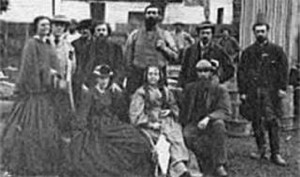Saturday morning, August 1, Indianapolis residents read a letter from a member of the 3rd Indiana Cavalry, published in the Journal, giving an account of the chase of the “notorious John H. Morgan” and his capture in Columbiana County, Ohio thus ending “one of the most memorable raids and pursuits on record.” Three hundred prisoners arrived on the Jeffersonville Railroad from Port Hudson and were marched from the depot under escort to Camp Morton. A few days later, 1,200 more prisoners arrived from Jackson, Mississippi. By mid-month, 300 additional rebel prisoners came from St. Louis. The military authorities at Camp Morton were besieged daily by fifteen to twenty persons from the “first families” of Kentucky wanting to give the prisoners something, but Col. Biddle refused them entrance. A detachment of the 63rd Regiment met “fierce resistance” while arresting deserters near Edinburgh in Johnson County. Four or five members of the “band of lawless traitors” lost their lives in the fight. Gov. Morton promptly replied to Gov. Curtin of Pennsylvania that Indiana would “contribute the expense of removing her dead” to the cemetery intended for a portion of the battlefield at Gettysburg. By the end of the month, preliminary arrangements for a National Cemetery “embracing the highest point on the Cemetery Hill” were completed.
President Lincoln proclaimed Thursday, August 6, as a day of thanksgiving for the recent victories. A great majority of businesses closed and the streets were mostly deserted. Church congregations were large and collections were taken up for the Christian Commission whose agents “are on every battlefield” and are found “in every hospital where there is a sick soldier.” The city regiment of the Indiana Legion had their usual weekly parade on University Square in the evening, followed by Rev George O. Betts, pastor of North Street Methodist Episcopal Church, stepping from the ranks of his company, where he serves as a private, to offer a prayer of praise and thanksgiving. The entire regiment then sang the Doxology “with great vigor and feeling.”
Long delayed official reports to Gov. Morton of the casualties sustained by Indiana regiments at Gettysburg began to appear in newspapers, and Hoosiers read the horrific accounts looking for the “loss of some relative or friend, or the happy termination of fears for their safety.” The 19th Indiana Regiment began the fight on July 1st with 261 men and 27 officers. After having its colors shot down five times and “being shelled almost constantly,” 69 men and 9 officers answered evening roll call at the end of the first day of fighting — “No regiment in the world has seen more deadly perils or met them more bravely.” The regiment’s wounded and those of other regiments of the Iron Brigade, many who had lost their knapsacks and nearly all with “clothing torn off, being covered with blood,” were brought to a neighboring house and barn at White Church, three miles from Gettysburg. Indiana’s Military Agent, Isaac W. Monfort, and his assistants brought shirts, drawers, bandages, socks, shoes, towels, vegetables, fruit, bread, butter, and Hoosier wine; “the soldiers were rejoiced to receive these supplies. ‘Bully for Indiana!’” Lists of killed and wounded were also compiled. The Indiana Sanitary Commission steamer Sunny Side left Evansville for Vicksburg and Natchez to pick up sick and wounded Hoosier soldiers. It carried a full contingent of surgeons and nurses and 1,000 packages of “well-assorted supplies.” Rev. W. R. Revels sent Gov. Morton a letter signed by himself and 90 other “colored inhabitants” of Indianapolis tendering their services as Home Guards. The governor declined the offer “in view of the superabundant force already organized in the Legion, and the fact that the constitution and laws of the State give him no authority to accept colored troops.” Levi Coffin, general agent of the Western Freedman’s Aid Commission was in the city soliciting donations to “aid in clothing, civilizing and Christianizing those slaves of the South who have been freed by the fortunes of war.”
The State Quartermaster General published a notice that severely rebuked unnamed parties for the “outrageous thoughtlessness” of using the door of the powder magazine west of Camp Sullivan for target practice. Messrs. White and Hill broke “the long dearth of entertainments” in Indianapolis with their performances of “Conscriptor Substitute” and “The Secret.” At College Hall, a capacity crowd gave a “perfect storm of applause” to Prof. Robert Kidd’s recitations “Negro Regiment” and “The Copperheads.” The State Convention of the War Democrats assembled at the State House grove Thursday morning August 20 with an opening salute from the 23rd Artillery Battery and “excellent music” provided by the 71st Regimental Band. A crowd of 15,000 cheered speeches, unanimously adopted resolutions, and in “thunder tones” gave emphatic affirmatives to calls for the Union and the Constitution and the “prosecution of the war until no last vestige of rebellion is left.”
Over 460 rebel prisoners at Camp Morton enlisted into the service of the United States and were assigned to the 71st and 73rd Indiana Regiments and the 12th Michigan Artillery Battery.



